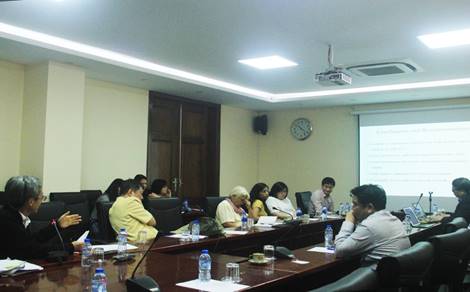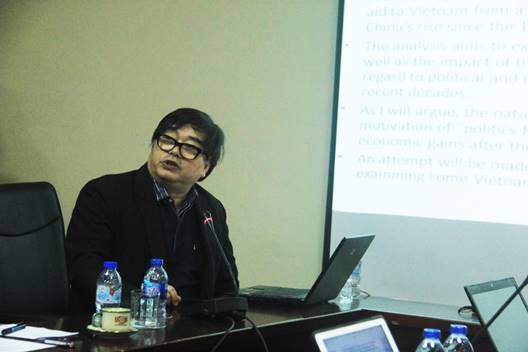The scientific discussion took place in an objective and open atmosphere. Delegates had in-depth discussions on China's growing influence on mainland Southeast Asian countries, including Vietnam, especially in the economic aspect.

Opening the discussion, Dr. Suthphand Chirathivat (Director of the ASEAN Studies Center, Chulalongkorn University, Thailand) presented a definition of China's growing influence over Southeast Asian countries. China builds this influence through many channels, including exporting goods to the ASEAN market, as well as providing subsidies to developing countries.

Dr. Suthphand Chirathivat presents a paper
Dr. Pham Anh Tuan (Institute of World Economics, Vietnam Academy of Social Sciences) shared about Vietnam's growing interdependence with the Chinese economy. He outlined a panoramic picture of Vietnam's foreign economic relations and presented comparative figures to show the growing dependence of Vietnam's trade on its largest partner, China, specifically in industry, agriculture and services. This partly reflects a form of North-South model. On the one hand, China is a supplier of many intermediate goods to Vietnam, including foreign direct investment (FDI). On the other hand, China is a frequent destination for "sensitive" products from Vietnam such as wood, food, and rubber. Currently, China is a large market, but it also causes many concerns for Vietnam. In conclusion, Dr. Pham Anh Tuan proposed a number of solutions such as finding alternative markets for both imports and exports (for example, ASEAN); Strengthen monitoring of agricultural product chains and output; set higher targets for Chinese investments and strive to compete and regain market share from this country.
Dr. Pham Anh Tuan presents his paper
Continuing the discussion, Associate Professor Dr. Nguyen Van Chinh presented a report with the topic: "Gift or burden? Limitations of Chinese aid to Vietnam". He shared that foreign aid from China is often motivated by the country's interests and general foreign policy goals. According to Associate Professor Dr. Nguyen Van Chinh, aid can originate from political, commercial, and even reputational concerns. It seems that China is trying to promote the government diplomacy model, while in recent years, people-to-people diplomacy has not been focused on. This shows the complex economic-political relationship between the two countries. Most of China's aid to Vietnam is in the form of preferential loans and always comes with strict terms such as requirements on raw materials for manufacturing technology and equipment.

Associate Professor, Dr. Nguyen Van Chinh presented his paper
From a comparative perspective, Dr. Anupama Devendrakumar (Center for ASEAN Studies, Chulalongkorn University, Thailand) pointed out the extent of influence of China and India on ASEAN countries. Recognizing the changes stemming from globalization, in recent years, the two Asian powers have made efforts to approach the economies of Southeast Asian countries, increasing their profound influence by providing aid to ASEAN countries. In addition, Dr. Thanyathip Sripana and Dr. Sothitorn Mallikamas (Chulalongkorn University, Thailand) also presented the perspective of China-Vietnam-Laos-Thailand relations, highlighting the opportunities and challenges that Southeast Asian countries have been receiving, through recent aid from Chinese investors and the government.
Author:Cao Hoang
Newer news
Older news